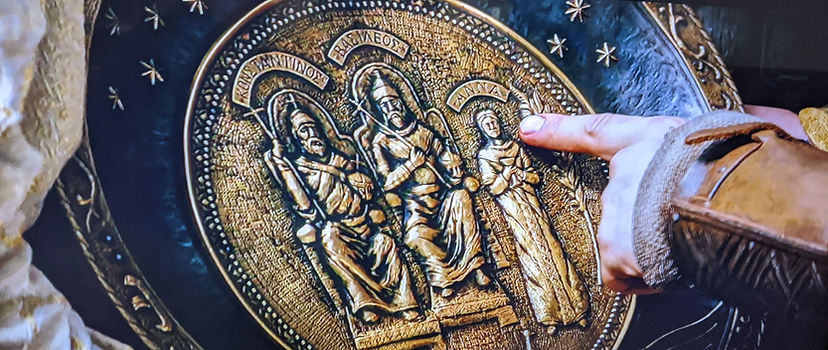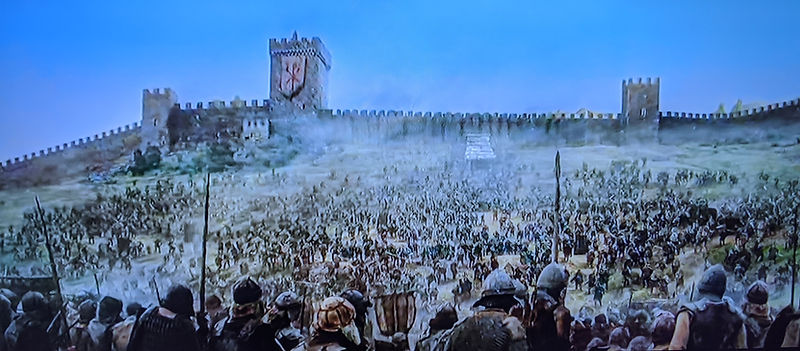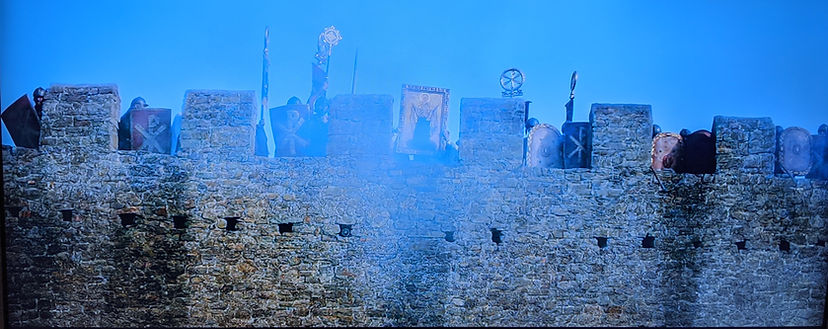Viking (2016)
“History is the symptom; we are the diagnosis” Viking (2016) starts, quoting Mao in a reference can only be traced back to another film: Nixon (1995). Dodgy citations aside, the point remains that Man is the plague: damaged and damaging. To Mao, the solution was Marxism. Spoiler: to Viking, the only way out of the crippling cycle of Original Sin we call “History” is conversion to Christ.
This nail is driven home by Vladimir the Great (d. 1015) played by Danila Kozlovsky, who I rather confusingly first viewed as another great prince of Novgorod in the TV series Vikings (2013-2019): Oleg the Prophet (d. 912). I saw every season of the TV series (as well as the slightly tedious Sofia [2016]) before returning to the film mainly because the movie’s trailer seemed to suggest it consisted of a three-hour siege (a Helm’s Deep mk.II) broken only by the token appearance of some devious and epicene Byzantines.
Thankfully, I was wrong. While the TV series had only Ragnor and then (less successfully) Bjorn dragging its storyline through a rather dull series of straight-up violence, religious thuggery and rapine (leavened only by new locations like Frankia and Rus-land) this film has an epic theme: the birth of Russia.
Amusingly this boils down to a biography on Vladimir who is rendered only slightly more psychologically interesting than Conan the Barbarian by painting him as willing to commit crimes (a bad trait) when slighted but also weak enough to be bullied into them by either his bold chief of staff, Sveneld, or some of his mercenary interests i.e. Viking gangs (an ambivalent trait) who chimp out on the slightest pretext.
His only truly redeeming feature is that he connects with the few Christians he encounters. We see this bond, first, with the warrior Theodore who – despite leading suicidal sorties against the Pechenegs on behalf of Kiev – is sacrificed by his zombified pagan homies (without Vladimir’s knowledge) to a totem that looks like the Zbruch Idol (now in Krakow, Poland). Second, with his love interest, Irina, played by Svetlana Khodchenkova. The former touchingly sings the ninety-first psalm as his wooden tower is reduced to saw dust in an axe-wielding version of Wicker Man (1973). The latter – stolen from a convent – reminds Vlad that there is only one God and that He can save him.
Impressively, the Christian excerpts are some of the best. Instead of lardy clumps of theology or tendentious evangelism crowbarred into a fluid script, it’s often vice versa with the pagan roundabout of desire, revenge and gory sacrifice becoming less exhilarating than exasperating. So while Vlad the Rus prince dances around a chessboard mined with Pechenegs from the Steppe, Romans from their poleis and Vikings from the seas, his journey is only provided with the force of direction and purpose by the snappy soundbites of the faith he hears; it’s the sort of peasant wisdom into which the viewer can readily believe Christianity was distilled. Examples include “There is no death, we will rise,” “I am God’s slave” and “We can forgive.”
Sadly, the Byzantine entry is a little bit of a cameo. Nevertheless, it’s immensely pleasurable to see them portrayed accurately as medieval Romans and – more to the point – positively. Modern-day Byzantines get to watch the Pechenegs fleeing at the sight of the Chi-Rho (on their dromons)[1] and one of my predecessors – a Byzantine Ambassador, no less – handing out silver plate (that looks remarkably like Theodosius’ Missorium) in exchange for favours. The script has Cherson rebelliously resisting Basil II (the Emperor responsible for creating the Varangian Guard) and he wants Vladimir’s help to crush it.
After Cherson is duly taken, Vlad confesses all of his sins to a bishop who happens to live in a cathedral that’s identical to San Vitale (Ravenna). The producer farcically sticks random segments of the church (like its lunettes for example) behind him i.e. head-height, such as the Lamb of God, Sacrifice of Isaac, St Mark, Abel Sacrificing and Three Angels with Bread.
Yet the cathedral scene (which oddly omits his baptism, a key episode in Russian history as commemorated in countless nineteenth-century paintings) is less of a climax than his confrontation with Svenheld at the seashore. The henchman seeks to kill his boss after the latter acknowledges that he’d refuse to assassinate the Emperor if granted an audience i.e. manifest a decent amount of will-to-power in Nietzschean terms.
“Show me some proof that you believe you will rise again instead of talking about it” (my paraphrase) Svenheld shouts at Vlad. Yet, as the prince kneels to face death (not for nothing is Svenheld called the “god of war”) – emphatically placing his skin in the game – Svenheld is forced to acknowledge that he is in the presence of the true faith and not garrulous posturing (though interestingly Svenheld isn’t a simple conversion case, instead he begrudgingly claims that Vlad has been spared only on account of the former’s age; he’s simply invested too much time in the prince and he’s too old to start life again).
Indeed, the final scene in which Svenheld can only bring his sword down on Vlad’s sword (rather than his head) reminds me of C. O. Cavafy. Just as the Alexandrian poet talked of the barbarians being “a kind of solution” so violence was only really a solution against violence in a fallen world; but Vlad’s emphatically not part of that world any more, he’s in one where salvation is possible: the perfect moment for the film’s final pull quote:
“For in this Hope we are Saved.”
(Romans 8:24)
This thematic element is smooth, effortless and beautiful. Being pedantic about the history is to miss the point. But as there’s sometimes a certain joy to missing it, let’s query on whose behalf Cherson rebelled in our 977-988 window (977 is when the film starts and 988 is when Vladimir was baptised).
One contender, Bardas Skleros, who routed Vlad’s father (Sviatoslav) in 970 (at Arcadiopolis) and then rose in rebellion c.976-79 might be an obvious bet but his power bases were located in the East (Armenia, Georgia and Asia Minor). There was no known conflict at Cherson. Again, the second contender, Bardas Phokas, raised a rebellion that was suppressed by Varangians in 989 but that was at Abydos (near modern-day Çanakkale) not Cherson.
Indeed, the city serves as a stark reminder of the New Rome’s power rather revealing anything about a particular historical episode. In dealing with tropes, the film’s producer manages to smuggle one negative stereotype about Byzantines into the mix, however. Apparently, “[The Romans] are not to be trusted.” Which is a bit rich given the Rus attacked Constantinople in 860 and assaulted Cherson on several occasions. As much is clear from previous diplomatic treaties that forbade the barbarians from attacking the latter, wintering there or allowing ships from the city to transport anybody who wasn’t recorded on their departure charters.
Perhaps the plot clips these negative encounters (as well as positive ones such as the conversion of Vlad’s grandmother [Olga] in tenth-century Constantinople, or the story of his envoys visiting the courts of the great faiths to measure the pros and cons of each) as it could only bear so great a load, but it feels a tad convenient to leave the tale in the euphoria of mass baptisms rather than, say, a sulky Anna Porphyrogenita (the emperor’s sister, promised to Vlad in return for aid) grumbling in her litter as she’s dragged into Barbaricum. Still, bruised egos aside, it’s great to see the Russians toying with the mythopoeic themes rather than the dross that passes for entertainment in the West.
[1] The Pecheneg fear of the Romans proved well founded considering on 29 April, 1091, they were wiped out so thoroughly by Alexios I and his Cuman allies that a rhyme was coined that went “All because of one day, the Pechenegs never saw the month of May!”









